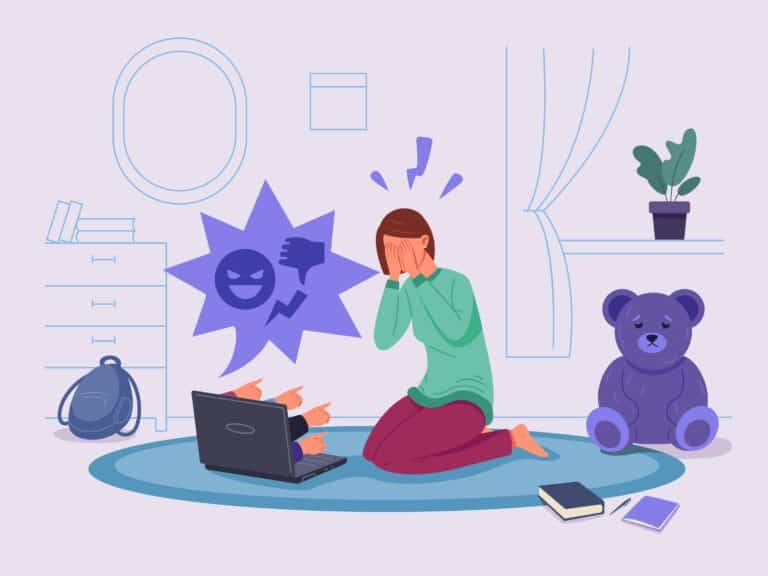- 27 June 2025
- 27 June 2025
- 3 min read
Speak to an expert : Live Chat
Often the burden to prevent cyberbullying falls on teachers, so how can schools work to create a safe environment, with healthy student relationships?
Learning about the signs and effects of cyberbullying is the first place to start. With students glued to their phones, online abuse is constant. It doesn’t stop when school finishes, or when a child is at home, and with many students feeling adults just won’t understand what they are experiencing, it is often hidden.
Cyberbullying shares some signs of traditional bullying: isolated, withdrawn children with reduced participation and confidence in the classroom. If a pupil is experiencing online abuse, you may see:
You can find out more about the different types of cyberbullying here. A content monitoring tool could also be a great way to help flag whether a student has undertaken any concerning online activity to suggest that they are being cyberbullied.
If it isn’t already, Cyberbullying should be included in your anti-bullying policy. Students will know clearly what will happen if the rules are broken. This not only helps deter cyberbullying, but supports current victims, showing that something will be done to stop it.
Each school will need specific measures in place based on their individual needs. To check whether your school’s current anti-bullying policy is effective – you can:
Once you’ve updated your anti-bullying policy, set up a plan of action to make improvements to ensure it is fit-for-purpose moving forward. Your policies may require changes based on the type of online bullying that’s happening.
Discussion between the victim and the bully should encourage empathy and understanding. Severe or recurring bullying should be met with a stricter approach.

Many cyberbullying victims aren’t comfortable talking to anyone about what they’re experiencing. Bullies work to isolate them from their family and peers, making it harder for them to reach out for help.
Teachers can help break this cycle by creating a class community, where each student is recognised for their strengths. Team exercises are a great way to foster friendship between different groups – try creating tasks that need a range of different skills so each student can shine:
The key point is that each pupil feels appreciated and important. This can be tough in a class of 30 students, which is why group and team based activities are ideal.
Once a healthy environment has been established, an open dialogue can begin:
Take a look at our article all about how to encourage conversation about online safety with your students.
Cybersmile has some fantastic resources, including learning programmes for different age groups and a toolkit for students wanting to help prevent cyberbullying.
Sometimes cyberbullying can be dealt with internally, between the victim and the bully, discussing and understanding the impact of their actions. If this doesn’t solve the issue, you may need to involve people from outside the school:
The best way to prevent cyberbullying is by staying connected. Talking to teachers, students and parents helps keep lines of communication open, so instances of online bullying can be reported quickly and dealt with efficiently. Try using the resources below to raise awareness in your school.
Cybersmile Education Programme – a series of modules covering the different aspects of cyberbullying and its effects
The Changemaker Toolkit – A document helping teenagers prevent cyberbullying in an active way online
Cybersmile Education Resources – Links learning programmes for different age ranges


For further information on our IMS Policy contact:



Exa is a trading name of Exa Networks Limited | Registered Company Number: 04922037 | VAT Number: 829 1565 09 | © Copyright Exa Networks Limited 2024 | All Rights Reserved
Exa is a trading name of Exa Networks Limited
Registered Company Number: 04922037
VAT Number: 829 1565 09
© Copyright Exa Networks Limited 2024 | All Rights Reserved
| Cookie | Duration | Description |
|---|---|---|
| cookielawinfo-checkbox-analytics | 11 months | This cookie is set by GDPR Cookie Consent plugin. The cookie is used to store the user consent for the cookies in the category "Analytics". |
| cookielawinfo-checkbox-functional | 11 months | The cookie is set by GDPR cookie consent to record the user consent for the cookies in the category "Functional". |
| cookielawinfo-checkbox-necessary | 11 months | This cookie is set by GDPR Cookie Consent plugin. The cookies is used to store the user consent for the cookies in the category "Necessary". |
| cookielawinfo-checkbox-others | 11 months | This cookie is set by GDPR Cookie Consent plugin. The cookie is used to store the user consent for the cookies in the category "Other. |
| cookielawinfo-checkbox-performance | 11 months | This cookie is set by GDPR Cookie Consent plugin. The cookie is used to store the user consent for the cookies in the category "Performance". |
| viewed_cookie_policy | 11 months | The cookie is set by the GDPR Cookie Consent plugin and is used to store whether or not user has consented to the use of cookies. It does not store any personal data. |
Monday: 8:30am – 5pm
Tuesday: 8:30am – 5pm
Wednesday: 8:30am – 5pm
Thursday: 8:30am – 5pm
Friday: 8:30am – 5pm
Saturday: Closed
Sunday: Closed
Email: helpdesk@exa.net.uk
Phone: 0345 145 1234
Monday: 8am – 6pm
Tuesday: 8am – 6pm
Wednesday: 8am – 6pm
Thursday: 8am – 6pm
Friday: 8am – 6pm
Saturday: 10am – 4pm
Sunday: 10am – 4pm